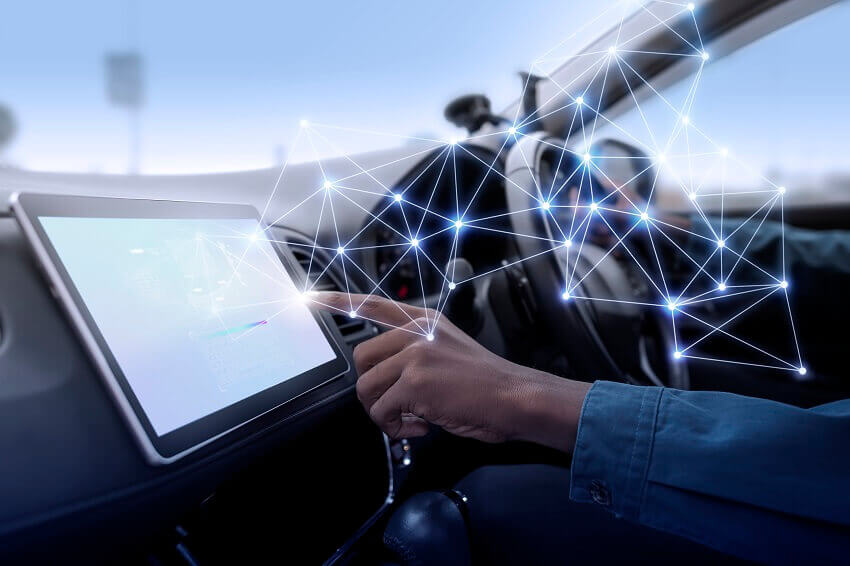Technology is present in every area of human life: Health, industry, sports, water, energy, homes, agriculture, and even means of transportation like cars. However, autonomous cars or self driving cars are not what you might think, or at least, they don’t work as we have seen in some futuristic movies, not yet.
We want to expose here some aspects of self-driving cars, information of their current state, and potential features for the future years.
Understanding autonomous cars
Many automaker companies are offering new cars with “self-driving functionalities”, however, these features are really basic compared to what a self-driving car really means. These vehicles adapt new technologies thanks to hardware development.
An autonomous car would perform completely on its own, that is, the vehicle is responsible for taking the passengers to their destination, it is fully autonomous, and it doesn’t require human intervention for making maneuvers such as slowing down, accelerating, changing lanes, turning left, turning right, or dodging a car or pedestrian to avoid a potential accident.
This description corresponds to level 5 of driving automation established by the Society of Automotive Engineers (SAE), in which the processes of the cars are completely automated. You could see it as a network of connected cars that interact between them,and send alerts to notify about a danger on the road or movements they will make. Taking the self-driven cars to this state would transform transportation into some kind of a hive that moves easily and without mistakes. But this kind of autonomous car technology doesn’t exist nowadays.
IoT is really important nowadays, these technology is being used in cars through tracking products, proximity sensors, wireless connectivity, motion and temperature control, among others (see fleet tracking device). The creation and inclusion of these devices are possible because of specialized companies inproduct development outsourcing.
There are companies like Waymo (former Google project) and Tesla that already have cars in the market with hands-off functionalities for the drivers. Nonetheless, according to the levels of driving automation established by the SAE, these cars would be located in the level 2 of autonomy; which still requires human assistance (on the car seat or from a control room), and the automated features correspond to semi-automated steering and speed.
How do self driving cars work?
Everything started with a google self driving car many years ago. The basic model allowed to transport a person at a low speed without the intervention of a driver; it was a basic prototype.
This project evolved over the years and transformed into Waymo. This company is operating its driverless cars in a little town of Arizona and in some suburbs of Phoenix. They have trained its AI with a vast data set of road images, and different scenarios for adapting to any condition. After thousands of miles tested without a driver, the company started offering rides to passengers in these areas of the US, however, they still cannot charge them for this service. They are still trying to figure out how to make this a profitable business, since every Waymo car costs around $200,000 dollars.
This company is making great advances, but they need more time to adapt each computer model to every city before they can fully expand to every city. That’s why it is so hard to launch self-driving cars everywhere.
Now we can talk about how Waymo autonomous cars work. These automobiles bring radars, more than 20 cameras attached to each side of the car, and the majority of components that control the car are in the trunk. These systems connect to a software and help the car to determine what it should do next.
Even though the cars are transporting passengers without the need of a driver,there is always a person monitoring the progress of the car and how it is performing on the street. If any risk shows up, this person can turn off the car from the control room.
There are also other cars in the market that claim to have autonomous functions, but they are still far from being a fully self-driven car. Some of the characteristics that make these cars more attractive to consumers are:
Adaptive cruise control
The car accelerates and brakes to keep a safe distance from the car in front.
Lane-centering steering with hands-on
This feature allows the vehicle to stay centered in an established lane, usually on highways. If the driver doesn’t have his hands on the wheel, the car will activate an alert and deactivate the automated functionality.
Steering (Hands-free)
This feature allows the driver to center the car in a specific lane without putting his hands on the wheel. The condition is that the driver keeps his eyes on the road or the system won’t work.
Pros and cons of self driving car technology
Among the pros of having fully self-driving cars, there could be a significant reduction of 90% deaths caused by cars in the US. Taking this cause of death from the second place to the ninth-leading cause of death in the country.
Stress would be reduced significantly, since the drivers wouldn’t need to be worried about driving the car. This could give them the opportunity to rest during the trip or dedicate themselves to other productive activities.
It is also necessary to consider the cons of autonomous cars. These kinds of vehicles can be disrupted by rain and snow and cause accidents.
The interaction between traditional cars and self-driven cars would require establishing lanes solely for autonomous cars, something similar to bus lanes. This would require a big amount of regulations and investing in improving the infrastructure of the roads.
If any accident happens, who will be responsible for that. The company or the owner of the autonomous car?
Finally, rising costs and tech limitations have slowed driverless car companies down. It is a market that has a lot of potential, but it also requires big amounts of funding.
Are self-driving cars the future?
IoT in the automotive industry is evolving fast, however, experts agree that fully self driving cars are a few decades away from now. Though some brand cars like Acura, Audi, BMW, Mazda, Tesla, Chevrolet, Chrysler, and others have some interesting functionalities for simulating an autonomous car, there is still a lot to be done in this market.
We invite you to comment below if you have any thoughts on this article, or if you have a car with special self-driving functions that we didn’t mention here.
Also, if you need IoT product development services, don’t hesitate to contact us to get a free consultation, we have been awarded as top 1 in IoT, and we have worked with clients in over 4 countries.





